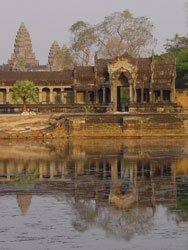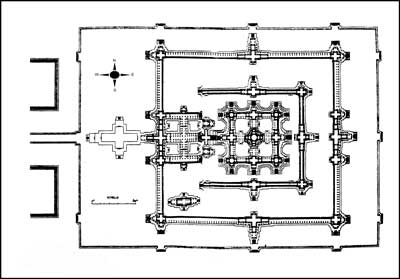Built in the mid 12th century by the Khmer empire in Cambodia country, it was built in honor of the god Vishnu. It takes 418 years to complete.
Angkor Wat (Khmer: អង្គរវត្ត), is a shrine or temple is located in the city of Angkor, Cambodia, and is regarded as one of the wonders of the world. It was built by King Suryavarman II in the mid 12th century. Angkor Wat temple construction took 30 years. Angkor Wat is located in the plain of Angkor temples which are also filled
with beautiful buildings, but Angkor Wat is the most famous temples in the Angkor plain. King Suryavarman II ordered the construction of Angkor Wat according to Hindu belief that putting the mountain Meru as the center of the world and is home to Hindu deities, with the central tower of Angkor Wat is the tallest tower in the main tower and a building complex of Angkor Wat.
As the mythological Mount Meru, the temples of Angkor Wat is surrounded by a wall and the canal which represents the ocean and the mountains that surround the world. The main entrance to the Angkor Wat half mile along the fence railing handrails decorated and flanked by man-made sea called Baray. The entrance to the temple of Angkor Wat through the gate, representing jambatan rainbow that connects the natural world to the realm of the gods.
Angkor Wat is in good condition compared to other temples on the plain of Angkor Wat Angkor due to have converted into a Buddhist temple and maintained and used continuously when replacing Hinduism Buddhism in Angkor the 13th century. Angkor temples never colonized by Siam in 1431.
In 1992 Angkor Wat in the list of UNESCO World Heritage Sites.
Modern name Angkor Wat, means "City Temple"; Angkor is an altered form of the word is derived from Nokor នគរ नगर word in Sanskrit nagara meaning capital or country. wat is the Khmer term for a shrine or temple. Previously the original name of this temple is the Preah Pisnulok or Vishnuloka (where the god Vishnu resides), based on the king's posthumous name builders, Suryawarman II.
 Angkor Wat is the visual, architectural and artistic heart. This is a three-tiered pyramid crowned by five towers of the lotus like rose 65 meters above the ground. Angkor Wat is the centerpiece of any visit to the temples of Angkor.
Angkor Wat is the visual, architectural and artistic heart. This is a three-tiered pyramid crowned by five towers of the lotus like rose 65 meters above the ground. Angkor Wat is the centerpiece of any visit to the temples of Angkor.
At the apex of Khmer political and military dominance in the region, Suryavarman II constructed Angkor Wat in the form of massive 'temple-mountain' dedicated to the Hindu god, Vishnu. He served as a state temple, though the temple is rarely westward orientation has led some to suggest that it was built as a funerary temple of Suryavarman II. Other temples of the same style and period include Thommanon, Banteay Samre, Atwea Wat and Beng Melea, which may have served as a prototype to Angkor Wat.
Angkor Wat is surrounded by a moat and exterior wall measuring 1300 meters x 1500 meters. The temple itself is 1 km square and consists of three levels surmounted by a central tower. Walls of the temple are covered inside and out with bas-reliefs and carvings. Given nearly 2,000 typical angel carvings adorn the walls throughout the temple and represent some of the best examples of angel carvings in Angkorian era art. But it is the exterior walls of the lower level that display the most extraordinary bas-reliefs, depicting stories and characters from Hindu mythology and the wars Suryavarman II history. It is in view of the bas-reliefs that a tour guide can be very helpful.
North reflecting pool in front is the most popular sunrise location. For sunrise, arrive very early, well before sunrise begins. The sun rises behind Angkor Wat providing a silhouette of Angkor typical shaped towers against the sky-colored sunrise. Some of the best colors appear just before the sun breaks over the horizon.
Visual impact of Angkor Wat, particularly on one's first visit, awesome. When you pass through the outer gate and get your first glimpse, the size and architecture make it appear two dimensional, like a giant postcard photo in the sky. Once you are through the gate and approach the temple along the road slowly gains depth and complexity. To maximize this effect you have to make your first visit in optimal lighting conditions, ie after 02:00. Do not make your first visit to Angkor Wat in the morning when the backlighting obscures the view.
The first level is the most artistically interesting. Most visitors begin their exploration with the bas-reliefs that cover the exterior walls of the first level, after the bas-reliefs counterclockwise around the temple. Relief highlights include the Battle of Kuru on the west wall mythology, military history marches Suryavarman II, builder of Angkor Wat, against the Cham, followed by scenes from Heaven and Hell on the south wall, and the classic 'spin on the Ocean Milk' on the east wall.
 Interior of the temple is not carved solid as the first level exterior, but still sports hundreds of fine carvings angel and scenes from Hindu mythology. A guide can be very helpful in explaining the story of the various chambers, statues and architectural forms can be found in the interior. On-top temple tour, the central tower on the third level houses four Buddha images, each facing a different cardinal point, highlighting the fact that although Angkor Wat was built as a Hindu temple, has served as a Buddhist temple since Buddhism became the dominant religion in Cambodia in the 14th century. Some say that it was my good fortune to pay homage to all four Buddha images before departing Angkor.
Interior of the temple is not carved solid as the first level exterior, but still sports hundreds of fine carvings angel and scenes from Hindu mythology. A guide can be very helpful in explaining the story of the various chambers, statues and architectural forms can be found in the interior. On-top temple tour, the central tower on the third level houses four Buddha images, each facing a different cardinal point, highlighting the fact that although Angkor Wat was built as a Hindu temple, has served as a Buddhist temple since Buddhism became the dominant religion in Cambodia in the 14th century. Some say that it was my good fortune to pay homage to all four Buddha images before departing Angkor.
Angkor Wat (Khmer: អង្គរវត្ត), is a shrine or temple is located in the city of Angkor, Cambodia, and is regarded as one of the wonders of the world. It was built by King Suryavarman II in the mid 12th century. Angkor Wat temple construction took 30 years. Angkor Wat is located in the plain of Angkor temples which are also filled
with beautiful buildings, but Angkor Wat is the most famous temples in the Angkor plain. King Suryavarman II ordered the construction of Angkor Wat according to Hindu belief that putting the mountain Meru as the center of the world and is home to Hindu deities, with the central tower of Angkor Wat is the tallest tower in the main tower and a building complex of Angkor Wat.
As the mythological Mount Meru, the temples of Angkor Wat is surrounded by a wall and the canal which represents the ocean and the mountains that surround the world. The main entrance to the Angkor Wat half mile along the fence railing handrails decorated and flanked by man-made sea called Baray. The entrance to the temple of Angkor Wat through the gate, representing jambatan rainbow that connects the natural world to the realm of the gods.
Angkor Wat is in good condition compared to other temples on the plain of Angkor Wat Angkor due to have converted into a Buddhist temple and maintained and used continuously when replacing Hinduism Buddhism in Angkor the 13th century. Angkor temples never colonized by Siam in 1431.
In 1992 Angkor Wat in the list of UNESCO World Heritage Sites.
Modern name Angkor Wat, means "City Temple"; Angkor is an altered form of the word is derived from Nokor នគរ नगर word in Sanskrit nagara meaning capital or country. wat is the Khmer term for a shrine or temple. Previously the original name of this temple is the Preah Pisnulok or Vishnuloka (where the god Vishnu resides), based on the king's posthumous name builders, Suryawarman II.

At the apex of Khmer political and military dominance in the region, Suryavarman II constructed Angkor Wat in the form of massive 'temple-mountain' dedicated to the Hindu god, Vishnu. He served as a state temple, though the temple is rarely westward orientation has led some to suggest that it was built as a funerary temple of Suryavarman II. Other temples of the same style and period include Thommanon, Banteay Samre, Atwea Wat and Beng Melea, which may have served as a prototype to Angkor Wat.
Angkor Wat is surrounded by a moat and exterior wall measuring 1300 meters x 1500 meters. The temple itself is 1 km square and consists of three levels surmounted by a central tower. Walls of the temple are covered inside and out with bas-reliefs and carvings. Given nearly 2,000 typical angel carvings adorn the walls throughout the temple and represent some of the best examples of angel carvings in Angkorian era art. But it is the exterior walls of the lower level that display the most extraordinary bas-reliefs, depicting stories and characters from Hindu mythology and the wars Suryavarman II history. It is in view of the bas-reliefs that a tour guide can be very helpful.
North reflecting pool in front is the most popular sunrise location. For sunrise, arrive very early, well before sunrise begins. The sun rises behind Angkor Wat providing a silhouette of Angkor typical shaped towers against the sky-colored sunrise. Some of the best colors appear just before the sun breaks over the horizon.
Visual impact of Angkor Wat, particularly on one's first visit, awesome. When you pass through the outer gate and get your first glimpse, the size and architecture make it appear two dimensional, like a giant postcard photo in the sky. Once you are through the gate and approach the temple along the road slowly gains depth and complexity. To maximize this effect you have to make your first visit in optimal lighting conditions, ie after 02:00. Do not make your first visit to Angkor Wat in the morning when the backlighting obscures the view.
The first level is the most artistically interesting. Most visitors begin their exploration with the bas-reliefs that cover the exterior walls of the first level, after the bas-reliefs counterclockwise around the temple. Relief highlights include the Battle of Kuru on the west wall mythology, military history marches Suryavarman II, builder of Angkor Wat, against the Cham, followed by scenes from Heaven and Hell on the south wall, and the classic 'spin on the Ocean Milk' on the east wall.

.jpg)
No comments:
Post a Comment